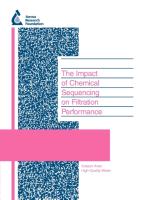The Impact of Chemical Sequencing on Filtration Perfomance
BücherAngebote / Angebote:
The primary objective of this research was to understand the impact of chemical sequencing and coagulation pH/zeta potential on filtration performance. The secondary goal was to determine effective coagulation processes in terms of pH, zeta potential, and coagulant dose for treating challenging (i.e., runoff-type) raw waters.
The following are highlights from this project:
Use of high coagulation pH (approximately 7.5) provided more consistent filtration performance over a wider range of coagulation conditions than lower pH levels.
Because higher pH significantly increases the optimum zeta potential range for filtration, a practical implication of this result is that use of a high coagulation pH process may be the most effective short-term treatment strategy for rapidly changing, runoff-type waters containing low alkalinity and high NOM levels.
The photometric dispersion analyzer (PDA) appears to be a useful alternative to jar tests for determining optimum coagulant doses and quickly evaluating different coagulation scenarios.
Folgt in ca. 15 Arbeitstagen




